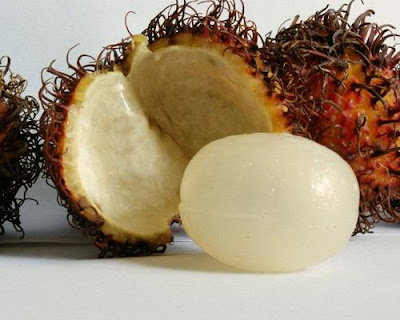Wracając z Davao
przywiźliśmy durian w samochodzie. Od naszej podróży minęło już tydzień, ale
zapach, po tym owocu w samochodzie, nadal pozostaje bardzo intensywny. Trudno
się go pozbyć. To typowa cecha tego słynnego owocu z Davao. Ludzie żartobliwie
mówią, ze „durian smakuje jak niebo, ale śmierdzi jak piekło.”
Durian (durio zibethinus) to duży owoc tropikalny
z bogatym i smacznym, miąszem, ale pokryty na zewnątrz skorupą z ostrymi kolcami.
Występuje w południowej Azji, a tutaj, na południu Mindanao (Davao), jest tak
popularny, że ten region potocznie nazywa się „republiką durianu.” Durian może
być spożywany na surowo, albo odpowiednio przyrządzony jako potrawa.
Dojrzały owoc
durianu może osiągnąć wielkość piłki do fulbolu amerykańskiego (30cm x 15cm) i
ważyć nawet trzy kilo. Jest smaczny i bogaty w witaminy. Dzięki tym szczególnym
właściwościom i wyglądowi, uważany jest
jako „król owoców.”
Poniżej na
zdjęciach i krótkim klipie, jest podana instrukcja otwierania durianu. Trzeba
to robić ostrożnie, aby się nie pokaleczyć.
Smacznego!
On the way from Davao we brought a durian in the car. It is
more than a week since we arrived here but the specific smell of that fruit remains
in the car. That’s why, many hotels and public transportation systems do not
let people carry durians because of the strong smell. Many will say that
"durian smells like hell and tastes like heaven."
A durian (durio
zibethinus) is a big fruit with a strong smell and a hard shell with sharp
thorns. Its flavor is loved by some people, especially in Southeast Asia, where
people name it "King of Fruits." Davao and south of Mindanao in the
Philippines is called the "durian republic."
The fruit can grow up to 30 cm long and 15 cm in diameter,
and usually weighs one to three kg. It is a tropical fruit. It grows only in
humid, hot places. The flesh is used for many dishes in Southeast Asian
cuisines. The seeds can also be eaten when cooked.
How to open and eat durian:
- With a long, sharp knife, carefully a make a deep cut into the durian about 8-10 inches long.
- Bury your fingers into the cut and pry the hull apart. When you are finished, you should have two halves.
- With the knife, make a deep cut into the fibrous divider along the center of the half. If the durian is very ripe, you will not need to do this.
- Pull the halved sections apart
- Scoop the edible flesh out of the husk and repeat with the other half.
- Consume/move the fruits that are visible first, then when you have half of the durian's visible fruit removed/eaten, put the palm of your hands on each side of the white inside of the durian. Apply a little force to crack the half-durian in two.
 |
| Durian tree |
 |
| Streets sign in Singapure. It prohibits durian in public places. |
























